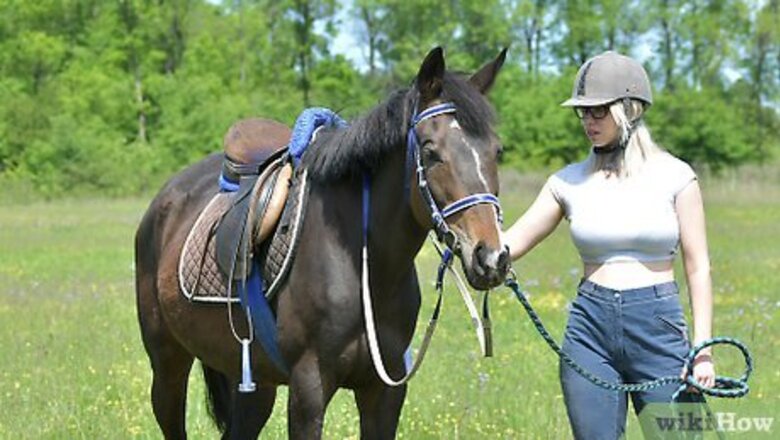
views
Positioning the Horse
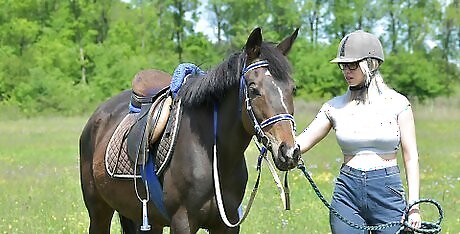
Move your horse into position. Walk your horse out to a level area for mounting. Make sure it isn't cramped, as horses can get claustrophobic easily. Traditionally, mounting occurs on the left side of a horse, so make sure the horse's left side is clear. However, a skilled rider can mount from either side of a horse. Once you learn to mount from the left side, it is important to learn to mount the right as well. Should you be in a dangerous situation, such as on a trail ride along a cliff edge, being able to mount and dismount from either side can keep you safe.
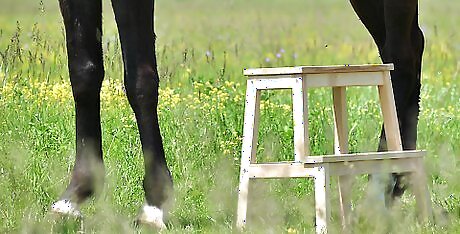
Move your mounting block into place. Although it is not required, a mounting block can make reaching the stirrups a bit easier. If you have a mounting block, move it so that it is just under the stirrup you will use to mount up. Repeatedly mounting without a block puts a lot of strain on one side of your horse's back, so using a mounting block can help reduce that strain and protect their back, as well as your body. Mounting blocks also help train your horse to stand still and not walk away while you’re trying to mount. Mounting blocks typically come with either 2 or 3 steps. The 2-step blocks tend to be shorter and they work well for most adults. The 3-step mounting blocks are taller and allow shorter and taller riders to use the same blocks.
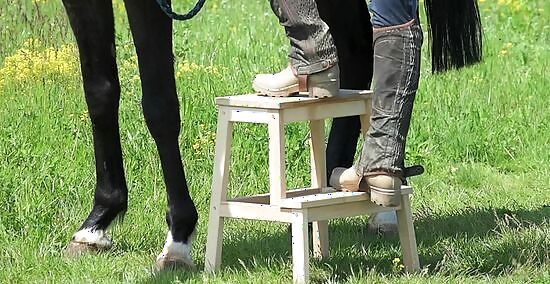
Position yourself next to your horse. In preparation for mounting from the left, whether you're standing on a mounting block or on the ground, you should stand next to your horse's left front leg. This allows you to reach the stirrup easily without sacrificing control of your horse. When you learn to mount on the right, you will start by the horse's right front leg.
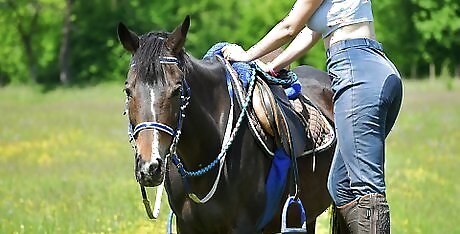
Keep the horse still. Make sure the horse is paying attention to you and isn’t trying to walk off. Put the reins over its head so they'll be in the correct position when you mount. Then hold onto the reins to keep the horse still while you mount. If you're a beginner, it's a good idea to ask a friend to hold your horse for you while you mount. Often during a lesson or at a horse show there will be someone available to hold your horse while you mount.
Climbing Onto Your Horse
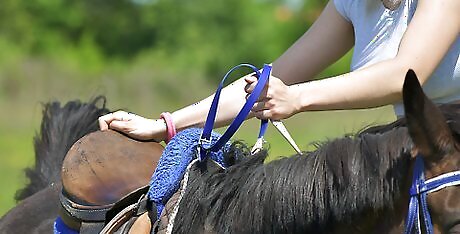
Grab the horse's reins. Holding onto the reins during the entire mounting process will help you control the horse in case they try to run away. The added gentle pressure of the bit in the horse’s mouth will remind your horse to stand still while you are mounting. If your horse starts to move while you're mounting, you can tell it "Whoa" or "Ho" and pull gently on the reins. As you are standing there, you should be holding the reins in your left hand. Keep them tight enough that you can control your horse if it moves away, but be careful not to pull too hard on your horse's mouth.
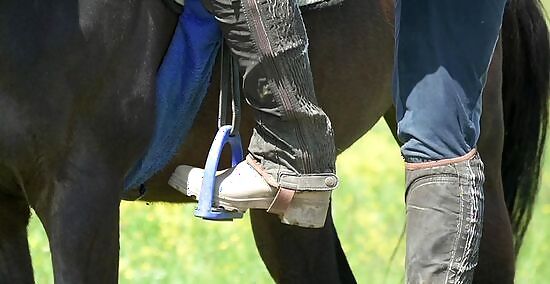
Put your left foot in the stirrup. This is much easier when using a mounting block, as you will be closer to the stirrup and will have to lift your leg, and eventually your whole body, a much shorter distance. However, if you are physically fit, it is doable to mount from the ground. Lift your forward foot (the one closest to the horse’s head) into the stirrup, so that your weight is resting on the ball of your foot. If you're mounting from the ground, you may want to drop the mounting stirrup several holes to make it easier to reach. You can then shorten your stirrup to the correct length once you're sitting on your horse. If mounting from the right, you will put your right foot in the stirrup.
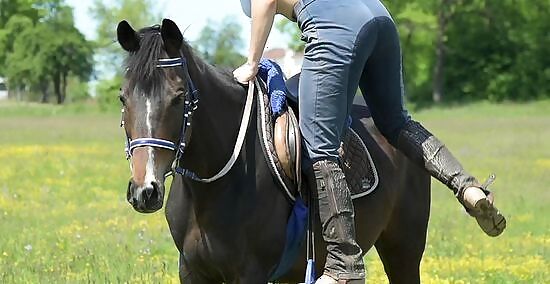
Pull your body up and onto the horse. Shift your body weight onto your mounting foot and swing your other leg over the top of the horse. If mounting from the left, your left hand should still be holding the reins, but you can grab the pommel of the saddle as well if necessary. If you’re riding in a western saddle, use your right hand to grab the horn. In an English saddle, use your right hand to grab the pommel. Avoid grabbing the back of the saddle, as it's less secure and pulling on it can cause the saddle to slip. If the saddle is too high off the ground or if you don’t have enough stretch in your leg, lift your leg with your arm or have a friend do the same. You can also ask a friend for a leg up to help you mount. Have them interlace their fingers and create a “basket” for your knee. Put your your knee in their hands, and they can give you a boost onto the horse. Be careful not to bump or kick the horse with your foot as you swing it over the top.
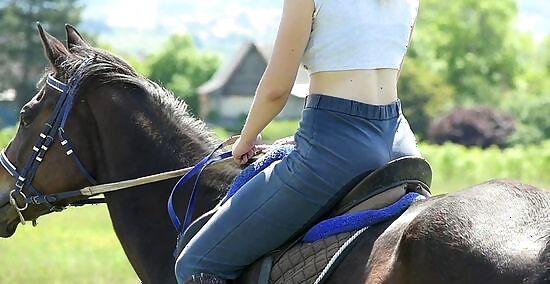
Slowly sink into the saddle. Landing hard in the saddle can hurt your horse's back. To avoid this type of injury, be careful to land gently in the saddle. This requires some muscle control, as you will create a lot of force when pulling your body up over the horse. Learning to do this properly may be slow-going at first, but over time you’ll be able to do this quickly and gently. Place both of your feet in the stirrups before you sit down. This will allow you to do a controlled sit and protect your horse’s back.
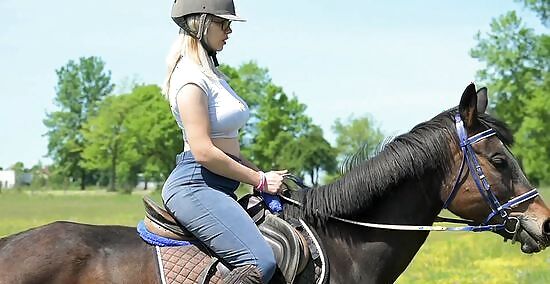
Adjust your positioning. When you are stable on the back of the horse, make minor adjustments to your seat and posture. Put your other foot in the stirrup, and adjust the length if necessary. After you have mounted, you should also check your girth again before you set off. Then grab the reins properly in your hands and you're ready to go!
Ensuring Safety and Comfort

Put on safety equipment. Remember to wear boots with a heel when riding a horse. This will help you to keep your feet in the stirrups. You should also wear an ASTM/SEI certified helmet and a safety vest when riding. This will protect your head in case of a fall. Get proper safety equipment that is made for riding horses. Wearing a helmet for another sport, for instance, will not protect you as well as wearing a helmet meant to protect horse riders.
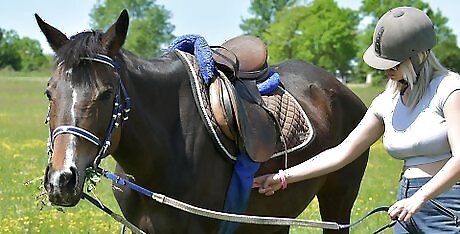
Check your horse's girth. The girth is the piece of the saddle that attaches around the horse's chest and keeps the saddle in place. Riding with a girth that is too loose or too tight is dangerous for you and your horse. To check the girth, make sure that it is tight enough to keep the saddle in place. However, you should be able to fit 2 fingers between the girth and the horse's side. Trying to mount a horse with a loose girth can cause you and the saddle to fall to the ground. This is why it's very important to check your horse's girth before mounting. Many horses dislike the girth and will puff up their chests for a looser fit when you try to put it on. For this reason, you should check and adjust your girth as necessary 5-10 minutes after you’ve started your ride.
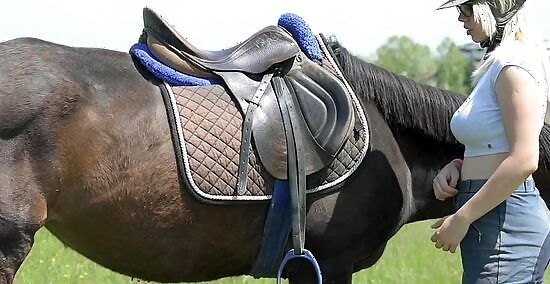
Adjust your stirrup length. Although you can adjust the length of your stirrups from the horse’s back, it’s much easier to do so before mounting. To get a relatively accurate gauge of your stirrup length, pull out the leathers of the stirrup towards your torso. Place your hand on the saddle, so your arm is perpendicular to your torso. Adjust the stirrups so that they reach the length of your arm, extending till just about your armpit. This method gives you a good foundation length, which can then be adjusted by a friend or yourself when you are in the saddle.
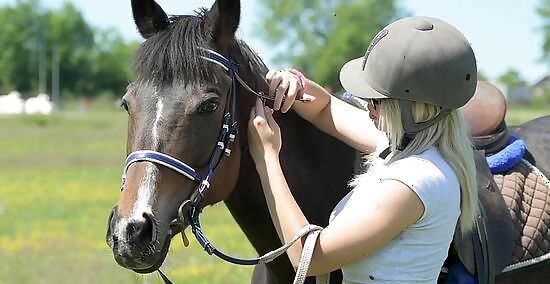
Adjust your reins. You should be able to have a good grip of the reins at all times during the mounting process. This will allow you to control the horse and ensure that it doesn’t walk off from under you. Shorten the rein opposite your mounting side so that you can add pressure to the bit and so that your horse looks away from you. Having the horse look away from you will eliminate the chance of it biting you while you are trying to mount.




















Comments
0 comment